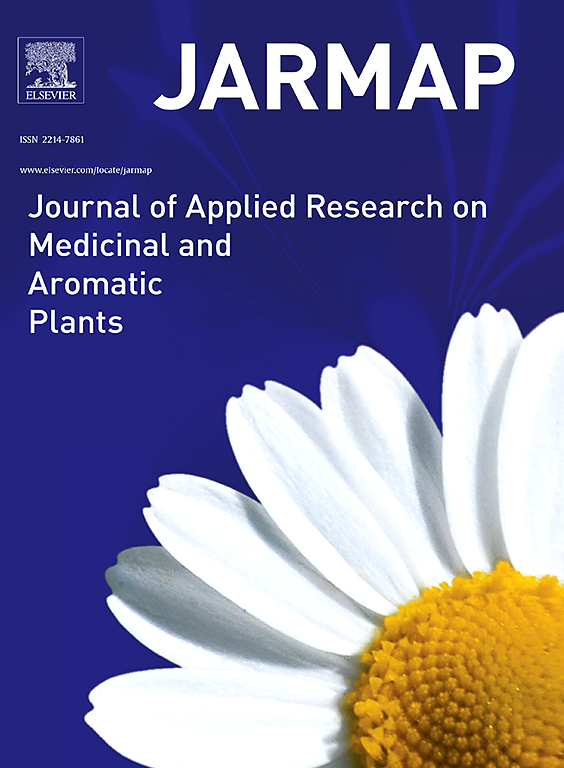高光照强度可提高药用大麻(Cannabis sativa L.)中特殊代谢物的产量,因为花序质量和代谢物浓度都更高
IF 3.6
2区 农林科学
Q1 PLANT SCIENCES
Journal of Applied Research on Medicinal and Aromatic Plants
Pub Date : 2024-09-21
DOI:10.1016/j.jarmap.2024.100583
引用次数: 0
摘要
药用大麻(Cannabis sativa L.)含有多种植物专有代谢物,如大麻素和萜类化合物。这些代谢物主要积聚在花序中,是种植的主要重点。药用大麻通常使用电灯进行室内种植,这样可以通过光照强度来优化产量和质量。虽然已知光照强度的增加会导致大麻花序产量的增加,但其对特殊代谢物的影响仍不清楚。我们的目的是量化光照强度对特殊代谢物产量的影响,并利用产量成分分析法阐明哪些植物性状可以解释这些影响。为此,我们在气候控制室中使用三种光强的宽波段白光 LED 进行了一项实验:600、800 和 1000 µmol m-2 s-1 光合光子通量密度 (PPFD),在大麻品种 "临界 CBD "的生长期(8 周,12 小时光周期)使用。随着 PPFD 的增加,大麻素和萜类化合物等专一代谢物的产量大幅增加,这是因为它们的浓度和花序产量都有所增加。花序产量随 PPFD 的增加而成正比增加,导致光利用效率保持不变。花序干重增加的主要原因是植物总干重的增加,其次是花序干重的增加。PPFD 较高的植物叶片光合作用较高。这项研究表明,大麻可以利用极高的光照强度,由于花序质量大、代谢物浓度高,因此专门代谢物的产量也高。本文章由计算机程序翻译,如有差异,请以英文原文为准。
High light intensity improves yield of specialized metabolites in medicinal cannabis (Cannabis sativa L.), resulting from both higher inflorescence mass and concentrations of metabolites
Medicinal cannabis (Cannabis sativa L.) contains various plant specialized metabolites, such as cannabinoids and terpenoids. These metabolites are mainly accumulated in inflorescences and are the primary focus of cultivation. Medicinal cannabis is often cultivated in indoor farming with electrical light, which allows for light intensities to optimize quantity and quality of production. Although it is known that an increase in light intensity results in increased inflorescence yield in cannabis, its impact on specialized metabolites remains unclear. We aim to quantify the effects of light intensity on the yield of specialized metabolites, and to elucidate which plant traits explain these effects, using a yield component analysis. Hereto, we conducted an experiment in a climate-controlled chamber using broad-band white LEDs at three light intensities: 600, 800, and 1000 µmol m−2 s−1 photosynthetic photon flux density (PPFD), applied during the generative phase (8 weeks with a 12-h photoperiod) in cannabis cv. ‘Critical CBD’. Yield of specialized metabolites, including cannabinoids and terpenoids, strongly increased with increasing PPFD due to increases in both their concentrations and inflorescence yield. The inflorescence yield showed a proportional increase with PPFD, resulting in a constant light use efficiency. The higher inflorescence dry mass was mainly caused by an increase in total plant dry matter production, and to a lesser extent a larger fraction of dry mass partitioned to the inflorescences. Leaf photosynthesis was higher for plants grown at higher PPFD. This study shows that cannabis can use very high light intensity, resulting in high yield of specialized metabolites due to high inflorescence mass and metabolite concentrations.
求助全文
通过发布文献求助,成功后即可免费获取论文全文。
去求助
来源期刊

Journal of Applied Research on Medicinal and Aromatic Plants
Pharmacology, Toxicology and Pharmaceutics-Drug Discovery
CiteScore
6.40
自引率
7.70%
发文量
80
审稿时长
41 days
期刊介绍:
JARMAP is a peer reviewed and multidisciplinary communication platform, covering all aspects of the raw material supply chain of medicinal and aromatic plants. JARMAP aims to improve production of tailor made commodities by addressing the various requirements of manufacturers of herbal medicines, herbal teas, seasoning herbs, food and feed supplements and cosmetics. JARMAP covers research on genetic resources, breeding, wild-collection, domestication, propagation, cultivation, phytopathology and plant protection, mechanization, conservation, processing, quality assurance, analytics and economics. JARMAP publishes reviews, original research articles and short communications related to research.
 求助内容:
求助内容: 应助结果提醒方式:
应助结果提醒方式:


